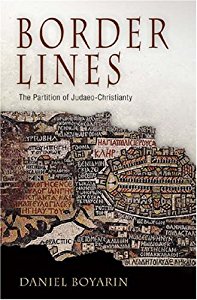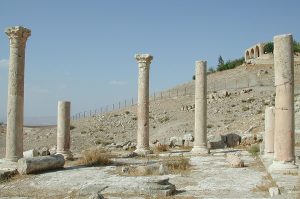Probably most people with more than a casual knowledge of Christianity recognise the following words as quintessentially Christian yet are completely unaware that when first penned these words were Jewish to the core:
In the beginning was the Word, and the Word was with God, and the Word was God.
The same was in the beginning with God.
All things were made by him; and without him was not any thing made that was made.
In him was life; and the life was the light of men.
And the light shineth in darkness; and the darkness comprehended it not.
Daniel Boyarin explains in Border Lines how these words came to be formulated through a Jewish literary process he calls “midrash” and how they are embedded in a first and second century CE Jewish religious culture that had room in which perhaps most Jews assumed a belief in what we might loosely call a second God or a Logos theology. This second God was variously known as Logos (Greek for “Word”), Memra (Aramaic for “Word”), Sophia (“Wisdom”), Metatron or Yahoel. Not that all these names are equivalent. They aren’t. They are a mix of genders for a start. But Daniel Boyarin conflates them all for purposes of his argument because he believes they are “genetically, as well as typologically, related.” (p. 275, and see also the previous post on the wave theory model of religious ideas.)
I’ll try to explain in a future post the actual midrashic process by which the author of the Gospel of John appears to have woven together passages from Genesis 1 and Proverbs 8 (and why he did this) to produce the above opening verses.
Where did the Logos come from?
Erwin Goodenough gave a definitive answer to that question in his 1968 book The Theology of Justin Martyr: An Investigation into the Conceptions of Early Christian Literature and Its Hellenistic and Judaistic Influences:
The Logos then in all circles but the Stoic . . . was a link of some kind which connected a transcendent Absolute with the world and humanity. The Logos came into general popularity because of the wide-spread desire to conceive of God as transcendent and yet immanent at the same time. The term Logos in philosophy was not usually used as a title or a unique attributed of God, but rather as the most important single name among many applicable to the effulgent Power of God which reasonably had shaped and now governs the world. (pp. 140-1)
Boyarin goes a step further and stresses
how thoroughly first-century Judaism had absorbed (and even co-produced) these central “Middle Platonic” theological notions. . . . The idea that the Logos or Sophia (Wisdom, and other variants as well) is the site of God’s presence in the world — indeed, the notion of God’s Word or Wisdom as a mediator figure — was a very widespread one in the world of first- and even second- century Judaic thought. (p. 112, my bolding)
Here is where Boyarin (and a good many other scholars of early Jewish thought) parts company with many scholars of the New Testament. (It seems to me that the latter have a tendency to find ways to dismiss the relevance of Jewish ideas if and where they rob early Christianity of its distinctiveness.) Yet the evidence for first century Jews being familiar with
- the notion of a great being alongside God himself and acting as God’s vice-regent,
- or with the idea that such a figure was actually a hypostasis or alternative manifestation of God,
- or with earthly notables like Adam, Israel, Enoch, Moses and others having pre-existing spiritual forms with especially exalted status in heaven and to which their earthly counterparts returned at death,
is very strong. These sorts of ideas were apparently common in first century Judaism.



